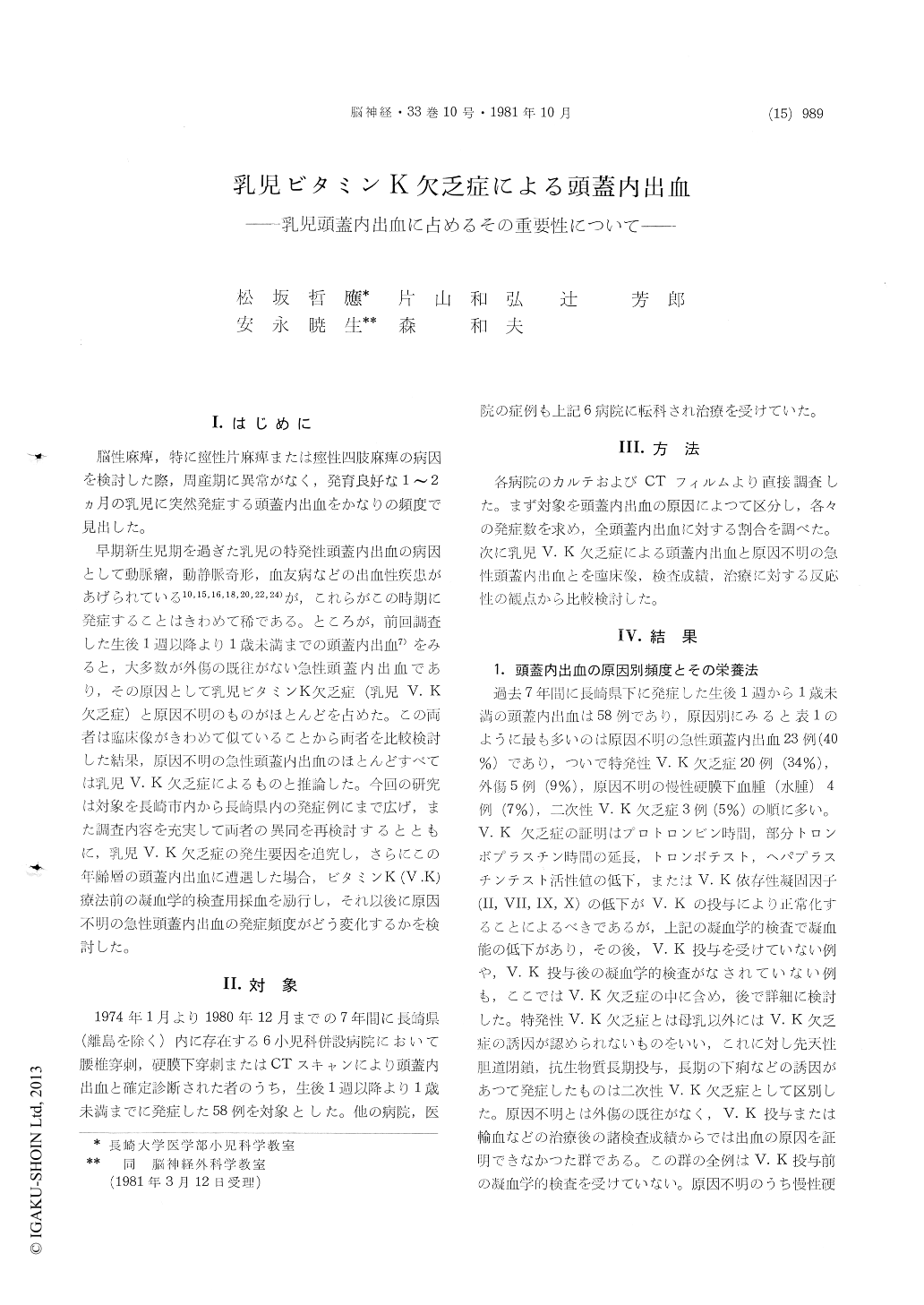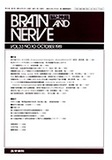Japanese
English
- 有料閲覧
- Abstract 文献概要
- 1ページ目 Look Inside
I.はじめに
脳性麻痺,特に痙性片麻痺または痙性四肢麻痺の病因を検討した際,周産期に異常がなく,発育良好な1〜2ヵ月の乳児に突然発症する頭蓋内出血をかなりの頻度で見出した。
早期新生児期を過ぎた乳児の特発性頭蓋内出血の病因として動脈瘤,動静脈奇形,血友病などの出血性疾患があげられている10,15,16,18,20,22,24)が,これらがこの時期に発症することはきわめて稀である。ところが,前回調査した生後1週以降より1歳未満までの頭蓋内出血7)をみると,大多数が外傷の既往がない急性頭蓋内出血であり,その原因として乳児ビタミンK欠乏症(乳児V.K欠乏症)と原因不明のものがほとんどを占めた。この両者は臨床像がきわめて似ていることから両者を比較検討した結果,原因不明の急性頭蓋内出血のほとんどすべては乳児V.K欠乏症によるものと推論した。今回の研究は対象を長崎市内から長崎県内の発症例にまで広げ,また調査内容を充実して両者の異同を再検討するとともに,乳児V.K欠乏症の発生要因を追究し,さらにこの年齢層の頭蓋内出血に遭遇した場合,ビタミンK (V.K)療法前の凝血学的検査用採血を励行し,それ以後に原因不明の急性頭蓋内出血の発症頻度がどう変化するかを検討した。
This study was intended to clarify that intracra-nial hemorrhage caused by vitamin K deficiency was one of the important causes of cerebral palsy.
During our previous study about the causes of cerebral palsy, we found that a great number of infants suffered from cerebral palsy caused by intracranial hemorreage during their early months of life.
After the neonatal period, ruptured intracranial aneurisms, A-V malformations, blood dyscrasias such as leukemia and hemophilia have been repor-ted as the causes of spontaneous intracranial hemorrhage. But the intracranial hemorrhage from these causes are rare in infancy. We have seen 58 cases of intracranial hemorrhage occured in infants aged from 1 week to 12 months in Naga-saki prefecture in the last 7 years. Of those 58 cases, 23 cases were acute intracranial hemorrhage caused by unknown etiology (group II) and 20 cases were caused by vitamin K deficiency (group I). We could not prove the etiology of group II, because vitamin K was given befome coagulation tests were performed. Group II could not be dif-frentiated from group I by clinical symptoms, laboratory data after vitamin K treatment, and CT scan findings. Patients of those two groups took almost the same clinical courses and prognoses. Both group I and group II showed following conditions whith were commonly seen in vitamin K deficiency patients.
1) They were all breast-fed infants.
2) The hemorrhage occured suddenly between 3 weeks to 8 months of age.
3) They were acute intracranial hemorrhage diagnosed by lumbar puncture, subdural pun- cture, brain CT scanning or by open-skull surgery.
4) They showed bleeding tendency such as purpura, hematemesis, bloody stool, oozing from puncture sites and/or multifocal intra- cranial hemorrhage.
5) Specific cause of intracranial hemorrhage could not be found after vitamin K treatment.
From these results, it is very suggestive that the cause of group II is the same as that of group I. In order to confirm this, we perfomed coagula-tion tests of all cases with intracranial hemorrhage and/or bleeding tendency less than one year old before vitamin K treatment since July 1979. Since then group II disappered and group I increased.
In our study, the incidence of intracranial he-morrhage due to vitamin K deficiency in infants was 1/2500 births.
It is very important that further studies should be done to prevent this tragic disease.

Copyright © 1981, Igaku-Shoin Ltd. All rights reserved.


